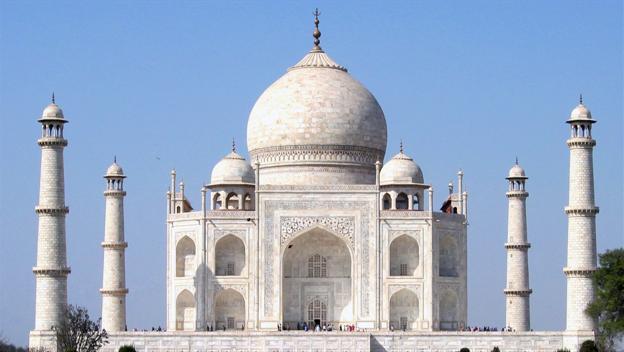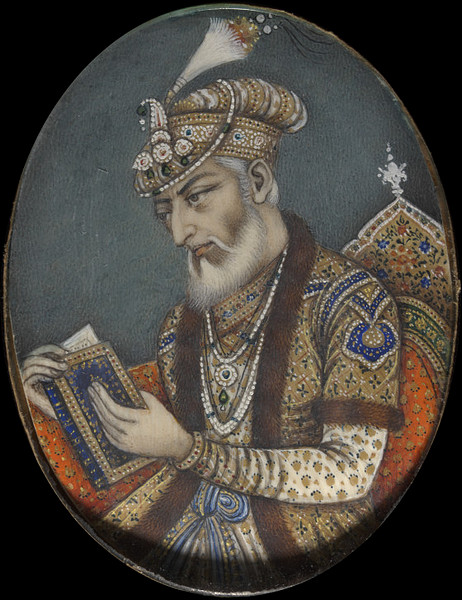
Also, her parents have the cutest dang love story of ever. So Imma tell it to you, even though it's not necessarily relevant. BEGIN. So, back in those days in India, the women of the court stayed in seclusion. Once a year, during a court festival called the Nine Days' Bazaar, the women of the harem came out (albeit heavily veiled) and ran the stalls at the bazaar, selling cutsy things like turbans and instruments. One of these little ladies was named Arjumand; she was the niece of the empress and a total catch. The prince of India named Khurram happened to be walking past her stall, and it was love at first sight. Even though he already had two wives (one was cranky and mean, and the other was a pretty chill Hindu chick), Arjumand was always his favorite wife.

Lookit how cute they are! I ship it.
So, getting back to something relevant- The emperor at the time (Jahanara's grandpa) was pretty senile, and his wife, Nur Jahan, pretty much controlled everything. This would've been all fine and dandy if Nur Jahan had been a decent human being. But nope, no such luck. A family rebellion exploded, Prince Khurram was exiled to the Deccan, his two eldest sons were kidnapped by the vile Nur Jahan, yada yada yada- and that's where our dear princess was born. Jahanara grew up as a super-mega-ultra posh nomad with her parents (and stepmamas) and siblings. She and her family moved around the Deccan, which was pretty much a wasteland (think the Indian version of Indiana, except with less agriculture). They lived in gigantic tents, drank from gold goblets, and had the finest clothes.
This all changed when her incredibly senile grandfather died died in October of 1627. As next in line to the throne, Khurram took the opportunity to move his family to the royal compounds at Fatehpur Sikri.
A legend claims that Khurram faked his own death by drinking goat's blood and spitting it up very graphically- basically faking his own death to make it seem like he wasn't a threat to the throne. Only his closest accomplices, including Arjumand, knew he still lived. Jahanara had to grieve for a few days, believing her dear father was dead. However, when the entourage reached the palace at Fatehpur Sikri, Khurram literally stood up from the funeral pyre and declared himself emperor of the entire Mughal Empire. Pretty cray, right?
He ordered all other competitors to the throne- including his own brother- executed, had Nur Jahan brought to his palace to be watched since she was one dangerous granny, and set about to restore the royal compounds. He became Shah Jahan, meaning "king of the world." His beautiful wife Arjumand became Mumtaz Mahal, which can be roughly translated as "crown beauty of the palace", and Jahanara inherited the prestigious title of Begum Sahib, Princess of Princesses. In other words, she became one of the most powerful women at court at the age of 14.
From this point on, Jahanara lived a life of complete luxury. Her rooms (which can still be seen today, although with slightly less splendor) were literally bejeweled. Rubies, sapphires, emeralds, and diamonds were quite literally built into the walls to create large flower designs. Tons of precious jewels were set into the marble floors and even into her own gigantic swimming pool in order to refract light underwater in an aesthetically pleasing way.

The doorway to Jahanara's room. In her day, each crevice on the wall would be filled with an individually carved jewel.

The palace of Fatehpur Sikri today.
Jahanara had the opportunity to be educated extremely well, especially in comparison with her European counterparts. She became a skilled poet, painter, architect, mathematician, philosopher, and engineer.
Unfortunately, in 1631, Jahanara's mother- Shah Jahan's most beloved wife, Mumtaz Mahal- died giving birth to her fourteenth child. It's madness. Fourteen dang kids. With no anesthetic. Mad respect for that woman.

Shah Jahan completely shut down after the death of his wife. The entire court went into mourning for what seemed like ages. He built the entire Taj Mahal as a final resting place for his wife; Jahanara actually helped with its design. Legend has it that Shah Jahan ordered that the hands of the builders were to be cut off so that they would never again be able to create something as beautiful. Weirdly sweet, huh?

As her father's favorite daughter, Jahanara pretty much singlehandedly pulled her father out of a deep depression and ruled by his side as the uncrowned empress of India. At one point, while attending a garden party, her heavily perfumed clothing caught on fire, burning her badly. Her father nursed her back to health, although it took months to do so.
Her father fell ill, and four brothers (three good, one bad) fought each other for the throne. Of course, by a cruel twist of fate, the one bad egg out of the bunch triumphed. His name was Aurangzeb, and he was a despotic, chauvinistic, and bigoted d-bag. He murdered two of his brothers (the third one fled and died of mysterious causes) and imprisoned his dying father (granted, he imprisoned him in a lavish palace, so it wasn't so bad). Jahanara cared for Shah Jahan in his dying hours.
Aurangzeb's reign was problematic, to say the least. Harem women were even more secluded than before, and Christians, Hindus, and any other non-Muslim individuals were tortured and persecuted.

What a dirtbag.
However, Jahanara was allowed certain privileges. She became the Padishah Begum-"Empress of Princesses"- under Aurangzeb's orders. With this title, Jahanara was permitted to disobey Aurangzeb's laws and criticize him. She blatantly wore clothing that women were no longer allowed to wear, refused to stay behind the screens of the harem, and embraced Hindus and Christians as her equals.
No one truly knows what Jahanara did in her final years. She did leave the royal palaces, lived in Delhi for the rest of her life, and commissioned several large and ornate structures, many of which still survive today. She never married, in accordance with the law of her forefathers- Mughal princesses were never allowed to wed. She composed many poems, painted, and continued the work of her parents in an artistic and architectural sense.
Jahanara died at the age of 67 in 1681. She had few personal possessions (you know, besides some clothes and extremely rare, prized jewels), which were left to her beloved niece. Aurangzeb ruled for another 26 years and is remembered for his cruelty, inhumanity, and bigotry. Jahanara, on the other hand, is still remembered by her people as a woman who had many powers in a time when women had few freedoms.
No comments:
Post a Comment